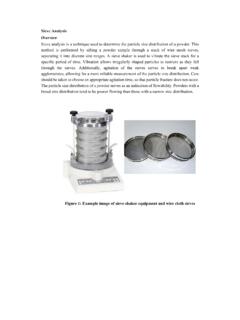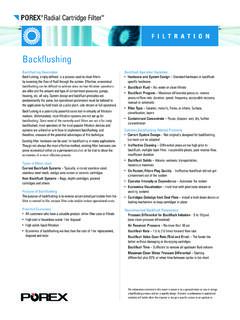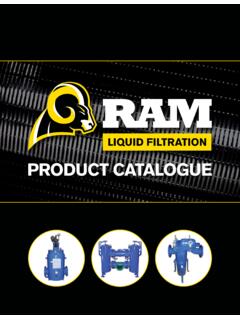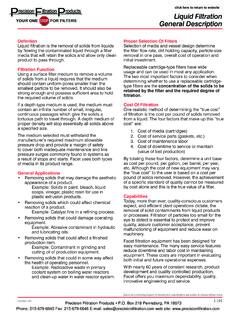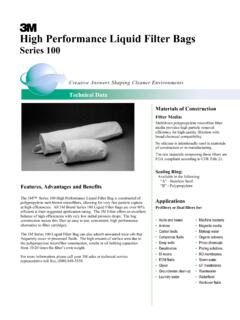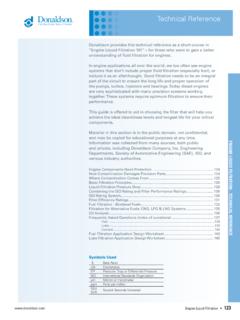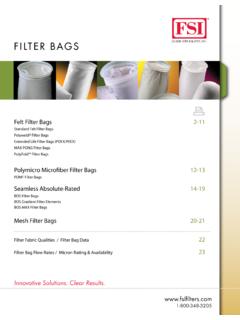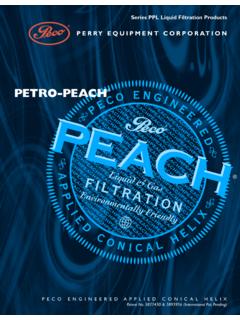Transcription of Cake Filtration Simulation - pharmaHUB - home
1 Cake Filtration Simulation Filtration models can be used to analyze and optimize Filtration operations. A cake Filtration equation, which describes the variation in Filtration flow rate as a function of operating parameters and physical properties, can be derived by applying Darcy s law to the filter cake and medium [1]. The cake Filtration equation can be written as follows, 2mdVPRcdtVAA (1) where t is Filtration time, Vis filtrate volume, is liquid viscosity, is the specific resistance of the cake, c is the dry cake mass per unit volume of filtrate, A is the Filtration area, mR is the filter medium resistance, and P is the combined pressure drop over the cake and medium.
2 Several different modes of operation are possible. These include constant rate Filtration , which corresponds to operation with a positive displacement pump, and constant pressure Filtration , which reflects the typical mode of operation for vacuum Filtration . In the latter case, the Filtration rate decreases with time as the filter cake builds up. For compressible cakes , the variation in cake properties with time must also be considered in developing a model of the Filtration operation.
3 The Filtration Simulation tool incorporates models and solution methods described in the literature [1-3]. The principal features of these models are presented below. Constant Rate, Incompressible Cake Filtration For constant rate Filtration , the cake Filtration equation can be rearranged to obtain a linear relationship between the Filtration pressure and filtrate volume, 2mRqcqPVAA (2) where dVqdt is the constant filtrate flow rate. The specific cake resistance and medium resistance can thus be determined from the slope and intercept of an experimental plot of Filtration pressure against filtrate volume.
4 Constant pressure , Incompressible Cake Filtration The performance of a filter being operated under constant pressure can be described by integrating and rearranging the cake Filtration equation to obtain the linearized parabolic rate law equation, 22mRtcVVAPAP (3) In this case, the specific cake resistance and medium resistance can be determined experimentally from a plot of filtrate time over volume against filtrate volume. Constant Rate, Compressible Cake Filtration When analyzing compressible filter cakes it is important to consider the variation in cake properties during the Filtration process.
5 This can be achieved by modeling the deposition of the cake, layer by layer, with the cake properties being recalculated at each step [2]. For a constant rate Filtration , the pressure drop required to maintain a constant flow will increase as the Filtration progresses. The increasing pressure will result in a compaction of the filter cake, with a consequent increase in the solids concentration and specific resistance. The variation in cake properties with pressure can be modeled using empirical relationships such as those given below, (1 )navocnP , (4) (1 )uavocCCuP , (5) where av and avC are average values, cP is the pressure drop across the cake, and o , oC, n and u are empirical constants.
6 The Simulation tool models the conditions for the formation of a new layer of filter cake. The pressure drop across the newly formed layer can be calculated from Darcy s law, navsavnPqCLA , (6) where q is the filtrate flow rate and nP is the pressure drop across the newly forming layer. The thickness nL of the newly deposited cake can be determined from a mass balance, nsavssLACQCt , (7) where Q is the feed rate of suspension and sC is the feed concentration expressed as a volume fraction. This can be calculated from the mass fraction s using the conversion 111sssCs.
7 The time t required for the deposition of the new cake layer can be calculated by combining the pressure drop and mass balance equations to obtain the following equation 2/navsstPAqQC . (8) The filtrate flow rate can be calculated from the feed rate, 1savCqQC . The Simulation calculation proceeds by incrementing the total pressure drop across the cake, computing the required Filtration time, and recalculating the cake properties at each increment. Constant pressure , Compressible Cake Filtration If medium resistance is neglected, then the entire pressure drop applies to the cake.
8 In this case a simple solution is possible, since the cake concentration and specific resistance will be constant for the duration of the Filtration step. For cases where the medium resistance is significant, the fraction of the overall pressure drop that applies to the cake will increase with time, resulting in an increase in cake concentration and resistance. An iterative calculation scheme for modeling compressible cake Filtration is proposed by Holdich [3]. The variation in cake resistance and concentration as a function of pressure can be modeled with empirical relationships as described in the previous section.
9 The filtrate volume can be calculated by rewriting the rate law as a quadratic equation, 2202avmcRVVtAPAP . (9) Here, c is the average mass of dry cake deposited per unit filtrate volume, which can be calculated from 111avavscCssC . (10) The filtrate flow rate can be calculated from the standard cake Filtration equation, 21avmdVqcRdtVAPAP . (11) The fraction of the overall pressure drop that applies to the filter cake can be calculated by subtracting the pressure drop over the medium from the overall pressure drop . mcRPPqA . (12) The iterative solution process begins with the assumption that the entire pressure drop applies to the filter cake.
10 This leads to an intial estimate of cake properties which can then be used to recalculate the pressure drop that applies to the filter cake. The new calculation incorporates the pressure drop acorss the medium. This leads in turn to a revised estimate of cake properties, and the iteration continues till the calculation of the pressure drop converges. Given the filtrate flow rate and cake pressure drop values, the height of the filter cake and the cake concentration profile can be calculated from the following equations 1(1)uncoosPALCunq , (13) 1uunuyocyCCPL.
